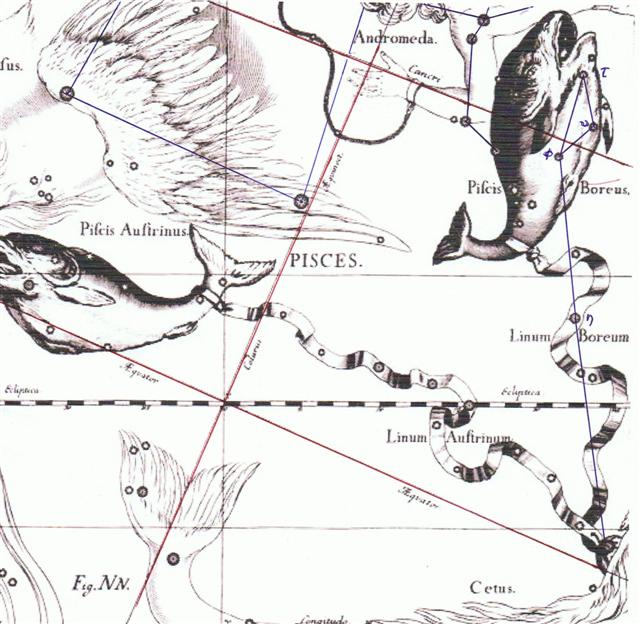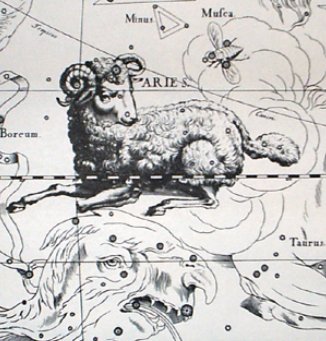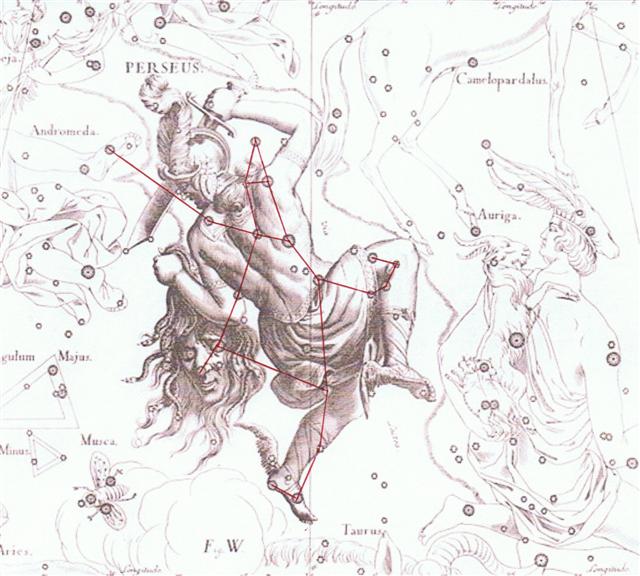The beginning of line
Cb1 has not yet reached
2h and the first 3
glyphs were possibly
drawn similar to the
previous 12 at the end
of side a in order to
draw attention to this fact:
|
Almuqaddam
12 |
13 (337) |
Al Muakhar 1 |
|
April 17
(107) |
18 |
19 |
 |
 |
 |
|
Cb1-1 (393) |
Cb1-2 |
Cb1-3 |
|
E tupu - ki roto |
o te
hau tea |
|
Polaris,
Baten Kaitos (26.6), Metallah (26.9), Segin,
Mesarthim,
ψ Phoenicis (27.2),
Sheratan,
φ Phoenicis (27.4) |
no star
listed |
Alrisha, χ
Phoenicis (29.2) |
|
October 18 |
19 |
20 (293) |
|
Assarfa 11 |
12 (156) |
13 |
|
φ Centauri (211.0), υ¹
Centauri (211.1) |
υ² Centauri (211.8), τ
Virginis (211.9), Agena (212.1) |
14h (213.1) |
|
Thuban
(212.8), χ Centauri (213.0), Menkent (213.1) |
Otherwise we could have said line Cb1 was
beginning at 2h. But probably Polaris was necessary to have at
the beginning.
Beyond hau tea with 'eyes', mata, looking in
both directions, and with the important Thuban,
α Draconis, visible in the
nakshatra sky, the true nature of the new year ought to be
described. Sun was at Alrisha, the Knot, in Pisces:

However, the text
appears to depict something else, viz. first a break in time,
possibly that
compared to the end of side a - or possibly the break from the
era of Aries to the era of Pisces:

|
Al Muakhar 2
(339) |
|
April 20
(110) |
 |
|
Cb1-4 (396) |
| ki te henua -
te maro |
|
2h
(30.4) |
|
Alamak
(29.7),
Hamal
(30.5) |
|
October 21 (294) |
|
Auva 1 |
| no
star listed |
|
Al Muakhar
3 (340) |
4 |
5 |
|
21 |
April 22
(112) |
23 |
 |
 |
 |
|
Cb1-5 |
Cb1-6 |
Cb1-7 (399) |
| no stars listed |
|
October 22 (295) |
23 |
24 |
|
Auva 2 |
3 (160) |
4 |
|
Asellus Tertius, κ
Virginis, 14
Bootis (214.8), 15
Bootis (215.2, Arcturus (215.4), Asellus Secundus
(215.5) |
Syrma, λ Bootis (215.6),
ι Lupi, 18 Bootis
(216.3), Khambalia (216.4), υ Virginis (216.5) |
ψ Centauri (216.6) |
| |
|
Al Muakhar 6 |
7 |
8 (345) |
9 |
| April 24 |
25 |
26 (116) |
27 |
 |
 |
 |
 |
| Cb1-8 |
Cb1-9 |
Cb1-10 |
Cb1-11 (403) |
| Mira (33.7) |
no stars listed |
|
October 25 |
26 |
27 (300) |
28 |
|
Auva 5 |
6 |
7 (164) |
8 |
|
Asellus Primus (217.8),
τ Lupi (218.1) |
φ Virginis (218.7), σ Lupi (219.1), ρ Bootis (219.5) |
Haris (219.7). σ Bootis (220.2), η Centauri (220.4) |
ρ Lupi (221.0), Toliman (221.2) |
|
rutua - te
pahu - rutua te maeva - atua rerorero - atua
hiko ura - hiko o tea - ka higa te ao ko te henua ra
ma te hoi atua |
Here I have not been able to connect
Metoro's words with specific glyphs, instead he seems to
explain all 7 at once. He is beginning by stating that drums
(te pahu) are sounding (rutua) as a greeting (maeva).
|
Pahu
Drum. Pahu-rutu-roa =
Long-beating-drum. Barthel.
M. Pahū.
Tree gong. Starzecka.
Pahu
uma, coffin; in modern
usage, any sort of jar. Pahupahu = To dig
a hole. Vanaga.
A trough, barrel, cask,
cradle, drum, chest, box;
pahu nui,
a kettle; pahu
oka, a drawer;
pahu papaku,
coffin; pahu
rikiriki, sheath;
pahu viriviri,
hogshead.
Pahupahu, box. Churchill.
A trough, barrel, cask,
cradle, drum, chest, box;
pahu nui,
a kettle; pahu
oka, a drawer;
pahu papaku,
coffin; pahu
rikiriki, sheath;
pahu viriviri,
hogshead;
pahupahu, box. P Mgv., Ta.:
pahu,
a drum. Mq.:
pahu, a drum, a large cylindrical
container. (To.:
bahu, a hollow tree set in water
as a filter.) Sa.:
pusa, a box. To.:
buha,
id. Fu.: pusa,
id. Niue: puha,
id. Pau.: puha,
id. Pahuahi,
lantern, beacon.
Paukumi, closet, cupboard.
Pahupopo,
a mould;
pahupopokai, cupboard for food.
Pahure:
1. To sweep everything away. 2. To wound, to
lacerate, scar, bruise, lesion, sore;
pahurehure,
to wound, to scratch;
hakapahure,
to wound. T Pau.:
pahure, to be skinned;
pahore,
to peel off, to scale. Mgv.:
pahore,
to cut off, to chop, to slice. Ta.:
pahore,
to flay, to skin. Churchill |
|
Rutu
1. To read, to recite, to
pronounce words solemnly; he-rutu i te kohau
motu, to read the rongorongo tablets;
hare rutu rogorogo mo hakama'a ki te ga poki ite
kai, i te rogorogo, rongorongo school, house
in which children were taught reading and
writing the rongorongo signs. 2. To pelt with
stones. 3. To gather in great numbers (of
people). Vanaga.
Sound. Rutu-rongorongo
= the sound of recitation. Barthel.
T. Beat. Henry.
To recite; tae rutu,
irreverence. Churchill.
Pau.: rutu, a drum.
Mgv.: rutu, to beat, to cause to resound.
Ta.: rutu, a drum, to drum. Mq.: utu,
to drum. Sa.: lutu, to shake a rattle.
Churchill. |
| Maeva
T. 1. Move. Rangi-maeva =
Moving Sky (name of a marae). 2. Greet,
greeting. Henry. |
The 28th and last Hindu station,
Revati, ruled by ζ Piscium (16.9) was associated not
only with fishes but also with drums.
The 1st Hindu station, Ashvini, was
ruled by Mersarthim (27.2) and Sheratan (27.4), and
associated with the head of a horse. These stars rose in
April 17 together with Polaris.
After the Horse's Head, connected with
April 17 by way of its ruling helical stars, followed the 2nd
Hindu station, Bharani, connected
with the asterism Musca Borealis (the Northern Fly) which evidently
corresponded to 'Yoni, the female organ of
reproduction'.
Due to Polaris etc I now dare suggest we
should try to understand the ruling stars of the Hindu system
of lunar stations as heliacal (at least as used at the
beginning of side b of the C tablet), and not related to the
nights when these ruling stars were visible
close to the full Moon.
The 'head of the horse' (April 17) was,
I guess, the male organ of reproduction, which ideally
should be joined with its female counterpart in linga-yoni:

And from there
to the 'head of the fly' (April 30) there were 13 days,
appropriate for the normal length of a lunar station:
|
Al Muakhar 10 |
11 (348) |
12 |
| April 28 |
29 |
30 (120) |
 |
 |
 |
| Cb1-12 |
Cb1-13 (405) |
Cb1-14 |
| manu rere - kua rere ga manu - ki te ragi |
eaha te nuku erua |
koia kua huki |
| no stars listed |
Head of the Fly (39.6), Kaffaljidhma (39.8), Angetenar (40.2) |
|
October 29 |
30 |
31 (304) |
|
Auva 9 |
10 |
11 (168) |
| π Bootis (221.8), ζ Bootis (221.9), 31 Bootis (222.0), Yang Mun (222.1), Rijl al Awwa (222.5) |
ο Bootis (222.9), Izar (223.0), 109 Virginis (223.3) |
Zuben Elgenubi (224.2), ξ Bootis, ο Lupi (224.5) |
| Al Muakhar 13 (350) |
Alrescha 1 |
2 |
| May 1 (121) |
2 |
3 |
 |
 |
 |
| Cb1-15 |
Cb1-16 |
Cb1-17 (409) |
| e niu tu |
ki te ariki - e ka hua ra tona rima |
koia kua iri i ruga o te rima - e o to vaha mea |
| Right Wing (40.9), Bharani (41.4) |
τ² Eridani (41.7) |
no star listed |
|
November
1 (305) |
2 |
3 |
|
Auva 12 |
13 (170) |
Simak 1 |
| Kochab (225.0) |
Ke Kwan (226.3), Ke Kwan (226.4) |
Zuben Elakribi (226.8), ω Bootis (227.2), Nekkar (227.3) |
May 1 is Gregorian day 121 (= 11 * 11) and corresponding to Al Muakhar 13 = manzil day 350. This could be the place, according to my interpretation, of the Niu (the cosmic Tree). This should be where it grows. Metoro, however, seems to connect it with mixing (tu), which of course is the basic fact of sexual reproduction.
| Tu To crush into puree, like women of old did, crushing sweet potatoes and mixing them with cooked egg to give the children. Vanaga.
To mix, to confound. Churchill. |
3h was quickly approaching and its position was connected with the first day after May 5 (5-25 where 5 * 25 = 125) when Alrescha 4 marked 12 * 29½ = 354 nights from the beginning of the manzil calendar:
| Alrescha 3 |
4 (354) |
5 |
| May 4 |
5 (125) |
6 |
 |
 |
 |
| Cb1-18 |
Cb1-19 |
Cb1-20 |
| manu moe ra |
ki to mata |
e nuku mata |
| Acamar (43.6) |
Menkar (44.7) |
3h (45.7) |
| Algol (45.9), Misam (46.2) |
|
November 4 |
5 |
6 (310) |
| Simak 2 (172) |
3 |
4 |
| Nadlat (227.8), π Lupi (227.9), Zuben Hakrabim (228.3) |
λ Lupi (228.9) |
κ Lupi (229.7), ζ Lupi (229.8), χ Bootis (230.2) |
Menkar (α Ceti) rose with the Sun and then in the next day was the eye of Medusa (Algol), her head severed from her body by Perseus. Misam is κ at the left arm of Perseus.

|
Tejat
Prior
(η
Gemini) |
0.2 |
κ
Aurigae
(93.6) |
|
... |
|
|
|
κ
Velorum
(141.5) |
|
|
|
κ
Leonis
(141.6) |
|
... |
|
η
Sagittarii |
0.6 |
κ
Lyrae
(277.5) |
|
Gredi
(α
Capricorni) |
0.9 |
κ
Sagittarii
(308.1) |
|
Bunda
(ξ
Aquarii) |
1.2 |
κ
Capricorni
(328.7) |
|
|
|
κ
Aquarii
(342.7) |
|
Revati
(ζ
Piscium) |
0.7 |
κ
Tucanae
(17.6) |
|
|
|
Algol
(β
Persei) |
0.3 |
κ
Persei
(46.2) |
The head of Medusa was probably once regarded as a separate asterism. The spiritual opponent of the gorgon Medusa, whose eyes turned men into stone, could have been the Northern Fly, also a separate asterism although nowadays belonging in the Aries constellation.
Line Cb1 is ending with 4 glyphs which possibly were introducing line Cb2:
| Alrescha 6 |
7 |
8 |
9 (359) |
| May 7 |
8 |
9 |
10 (130) |
 |
 |
 |
 |
| Cb1-21 (413) |
Cb1-22 |
Cb1-23 |
Cb1-24 |
| hoea |
ko te rima |
kua oo ki te vai |
ma te ua |
| Botein (46.9) |
Zibal (48.0) |
no star listed |
Algenib Persei (50.0), ο Tauri (50.2) |
|
November 7 |
8 |
9 |
10 (314) |
| Simak 5 |
6 |
7 (177) |
8 |
| Princeps (230.6), Zuben Elschemali (230.8), μ Lupi (231.3) |
ο Cor. Borealis (232.0), δ Lupi (232.1), φ¹, ν² Lupi (232.2), ν¹ Lupi (232.3), ε Lupi (232.4), φ² Lupi (232.5) |
Pherkad (232.6), η Cor. Borealis (232.8), υ Lupi (232.9), Alkalurops (233.1) |
Nusakan (234.0) |
According to Metoro glyph 413 (= 14 * 29½) should be thought of as the point of a hoea ('tattoing instrument'), while Algenib Persei (50.0) was connected with rain (ma te ua).
At the other end of the year it was the Gregorian π day, i.e. 130 (May 10) + 184 = 314 (November 10).
|


















